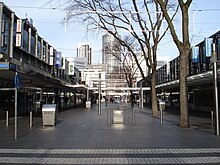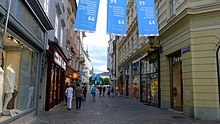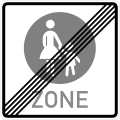Pedestrian zone

A pedestrian zone (officially pedestrian area in Germany until 2013 ; in northern Germany also Gehstraße , especially in the district of Dithmarschen ) is a traffic area on which pedestrians have priority or exclusive right of use over other road users . In most cases, other road users, especially motorized traffic, only have a right of access at certain times (for example, when goods are being delivered or as residents). The pedestrian zone can consist of several pedestrian streets and is usually located in the interior of a city, a district or a settlement.
The design of the street space is adapted to the needs of pedestrians ; the attractive surface design of the pavement and furnishing (benches, lighting, fountains and trees) create a design effect that increases the quality of stay. In addition, pedestrian zones are often lined with shops, restaurants and cafes.
history



The planning and establishment of the first pedestrian zones began in Europe in the 1950s . Before that, car-free zones and car-free roads were set up in various places, for example in the USA on Mackinac Island or in Argentina's capital Buenos Aires . A forerunner of the pedestrian zones in Germany , more precisely a traffic-free shopping street, was laid out in Limbecker Strasse in Essen in 1927 before the Second World War . The flooring was also replaced and redesigned to make it pedestrian-friendly. The street is still a pedestrian zone today.
- In 1953 the Lijnbaan shopping street in Rotterdam was also closed to vehicle traffic and completely dedicated to pedestrian traffic.
- In Germany, on November 9, 1953, stairs street in Kassel was opened for pedestrian traffic. It emerged from a reconstruction competition in 1947 because the city center of Kassel was badly damaged by the bombs .
- Kiel followed with Holstenstrasse on December 12, 1953; Corresponding plans had been in place here since 1950/51, but approval was only given two years later.
- Also Stuttgart yet declared the end of 1953, the school road, a transverse axis between the King Street and the Market Place , the pedestrian area.
- The first pedestrian zone in Austria was built in 1961 in Klagenfurt's Kramergasse.
- With the development of the war-torn northern section of the Breiten Weg (then Karl-Marx-Straße ) in the first half of the 1960s, the first pedestrian zone in the GDR emerged in Magdeburg .
- On February 23, 1966, the Schildergasse in Cologne was declared a pedestrian area.
- Also in 1966, the Pfannenschmiedsgasse and the Breiten Gasse, the first pedestrian zone, were built in Nuremberg , which now extends continuously from the Aufseßplatz in the southern part of the city to large parts of the Lorenzer and Sebald old town .
- The pedestrian zone in Oldenburg , established in 1967, is the oldest area-wide pedestrian zone in Germany, i.e. not limited to individual streets.
- In 1970 Fischerstrasse in Kempten (Allgäu) was opened as the first developed pedestrian zone in Bavarian Swabia .
- The plans for the Summer Olympics in Munich also included the extensive renovation of the old town and the construction of a wide-ranging pedestrian zone around Kaufingerstrasse , which opened on June 30, 1972.
Origin and Distribution
In some cases, in the 1950s, the opportunity to rebuild city centers that had been destroyed in World War II was used to plan and equip pedestrian zones as an element of modern urban development . This was increasingly implemented as a concept from the 1970s, on the one hand to spatially separate traffic, shopping and living, but on the other hand to ensure the bundling of the main traffic flows. Since then, pedestrian zones have been an essential part of urban planning, separating pedestrian traffic from motorized individual or public traffic and, together with the construction of parking garages , parking guidance systems and underground railways (the development of the so-called light rail system also falls within this period), individual traffic order and optimize quality. Shopping is to be encouraged in pedestrian zones, they have become a symbol of prosperous economic life and in many places a central place for mass consumption . Especially in medium and large cities located next to find there specialty stores and other forms of operation of retail and large purchase and department stores . In 2011 there were 170 pedestrian zones in Germany.
The spread of pedestrian zones has remained largely restricted to Europe. In Germany today there are pedestrian zones in many large , medium-sized and small towns , while in the USA only a few are left of the pedestrian zones created primarily in the 1960s. In 2009, New York Mayor Michael Bloomberg's plan to temporarily make parts of the famous Broadway a pedestrian zone caused a stir . Vehicles were temporarily banned from driving along the 500-meter-long section between 42nd and 47th streets, which also includes Times Square , and between 33rd and 35th streets. For taxi drivers and suppliers, the plan met with resistance. However, due to the positive experience, the pedestrian zone was retained.
Legal norms
The relevant road traffic authority is responsible for the facility (in Germany according to § 45 Paragraph 1b No. 3 of the Road Traffic Regulations ).
The traffic rules for pedestrian zones and their signage are largely similar ( § 10 StVO with reference to the traffic signs 242.1 and 242.2). Pedestrian zones are intended for use by pedestrians. Other road users are generally prohibited from using it. Appropriate signs can, however, allow their access (temporarily), they are then to be regarded as subordinate and must adapt their speed and driving behavior to the pedestrian traffic. Exceptions apply in most cases for hardening , disposal and street cleaning vehicles , sometimes for vehicles of public transport ( § 35 para. 7a Highway Code).
Vehicles in pedestrian zones are not bound by the right-hand drive (in countries with right-hand drive), and there are no right of way or parking rules. Only the general rules of conduct apply, in Germany: § 1 StVO.
In Germany, Austria and Switzerland, a corresponding sign is placed at the beginning and end of a pedestrian zone. In Switzerland, the word “ZONE” is written in the respective regional official language.
Traffic signs / regulation signals
The first two traffic signs for pedestrian zones were published in Germany with the ninth ordinance amending the road traffic regulations of March 22, 1988, which became legally valid on October 1 , 1988 and which was published in the Federal Law Gazette, Part 1, No. 12. With the sign 242 (beginning of a pedestrian area) and the sign 243 (end of a pedestrian area) it was now possible to point out this special traffic area uniformly and explicitly throughout Germany. With the German StVO amendment, which came into force on September 1, 2009, the word “pedestrian area” was renamed “pedestrian zone” and thus became part of the new version of the Road Traffic Regulations, which came into force on April 1, 2013.
- Signs in the countries D – A – CH
See also
- Encounter zone
- Bernese model
- Pedestrian friendliness
- Pedestrian safety
- Shared Space (German: "common space")
- Traffic calming
- Woonerf (Dutch concept for traffic calming)
literature
- Adelheid von Saldern : City and communication in times of upheaval in the Federal Republic of Germany . Franz Steiner Verlag, 2006, ISBN 3-515-08918-7 ( City and communication in times of upheaval in the Federal Republic of Germany ).
- Helmut Holzapfel, Folkert Kiepe , Michael Lehmbrock, Peter Müller, Ulrike Reutter: HKV - Handbook of Municipal Transport Planning . Ed .: Dieter Apel, Tilman Bracher. tape 33 . Wichmann, Herbert, Verlag GmbH, 2003, ISBN 978-3-87907-400-6 ( Google Books ).
Web links
Individual evidence
- ↑ Dietmar König: walkway. August 2, 2001, accessed February 22, 2015 .
- ^ Frank Höfler: traffic planning . In: Transportation Practice . tape 1 . Bauwerk Verlag, Berlin 2004, ISBN 3-934369-52-9 , p. 233-235 .
- ^ Renate van der Zee: Walk the Lijnbaan: decline and rebirth on Europe's first pedestrianized street. In: The Guardian. The Guardian, September 19, 2018, accessed September 23, 2018 .
- ↑ Information from the City of Kassel on the pedestrian zone ( Memento from January 11, 2012 in the Internet Archive )
- ↑ Schulstrasse ( Memento of the original from December 14, 2013 in the Internet Archive ) Info: The archive link was automatically inserted and not yet checked. Please check the original and archive link according to the instructions and then remove this notice. , www.Stuttgart.de
- ↑ Pedestrian zones - Nuremberg Transport Planning Office at nuernberg.de, accessed on April 24, 2019
- ↑ Records or something special , City of Oldenburg.
- ↑ Karsten Röhr: Anniversary in Oldenburg: Germany's first pedestrian zone turns 50 . Article in the Nordwest-Zeitung on February 22, 2017. Accessed November 27, 2017.
- ↑ Simone Egger: "Munich is becoming more modern". City and atmosphere in the long 1960s . Transcript, Bielefeld 2013, ISBN 978-3-8376-2282-9 , p. 228.
- ↑ These pedestrian zones shape Germany on welt.de
- ^ Anniversary of the pedestrian zone on sueddeutsche.de
- ^ KK: Cycling in pedestrian zones. General German Bicycle Club , Landesverband Nordrhein-Westfalen e. V., August 15, 2012, accessed February 22, 2015 .
- ↑ These are Germany's most popular shopping miles , report in STERN on August 5, 2011
- ↑ Forty-sixth ordinance amending road traffic regulations v. August 5, 2009 (BGBl. I p. 2631), full text and synopsis , BGBl. I p. 2631
- ↑ Ordinance on the new version of the Road Traffic Act (StVO) . In: Bundesgesetzblatt , Part I, 2013, No. 12 of March 12, 2013, pp. 367–427; here: p. 388.







